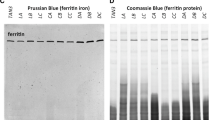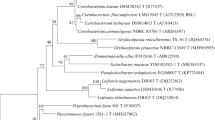Abstract
In Drosophila melanogaster, the chitinous microfibrils arising from the tips of the epidermal villi in adult cuticles remain irregular and loose in the mutant ebony (which fails in cuticular incorporation of β-alanine) but closely knit and regular in normal flies. Addition of β-alanine to cuticles from which nonchitinous materials have been removed with alkali converts the loose arrangement of the microfibrils to a compact and sharply delineated arrangement. β-alanine also accelerates tyrosinase-catalyzed oxidation of N-acetyldopamine by reacting with the oxidized product of the reaction to produce an orange-red complex. Similarly, β-alanine accelerates oxidation of N-acetyldopamine when these two substances are added to fluids from the hemocoel, to lead to tanning instead of normal blackening. These findings may help explain why β-alanine induces tanning while inhibiting melanization in insects.
Similar content being viewed by others
References
Bodnaryk, R. P. (1971a). Studies on the incorporation of beta-alanine into the puparium of the fly, Sarcophaga bullata. J. Insect Physiol. 171201.
Bodnaryk, R. P. (1971b). N-terminal beta-alanine in the puparium of the fly Sarcophage bullata: Evidence from kinetic studies of its release by partial acid hydrolysis. Insect Biochem. 1228.
Fukushi, Y. (1967). Genetic and biochemical studies on amino acid compositions and color manifestation in pupal sheaths of insects. Jap. J. Genet. 4211.
Fukushi, Y., and Seki, T. (1965). Differences in amino acid compositions of pupal sheaths between wild and black pupa strains in some species of insects. Jap. J. Genet. 40203.
Hodgetts, R. B., and Choi, A. (1974). Beta-alanine and cuticle maturation in Drosophila. Nature 252710.
Hodgetts, R. B., and Konopka, R. J. (1973). Tyrosine and catecholamine metabolism in wild-type Drosophila malanogaster and a mutant, ebony. J. Insect Physiol. 191211.
Hotta, Y., and Benzer, S. (1969). Abnormal electroretinograms in visual mutants of Drosophila. Nature 222354.
Jacobs, M. E. (1960). Influence of light on mating of Drosophila melanogaster. Ecology 41182.
Jacobs, M. E. (1961). Sex differences and environmental influence on DOPA-oxidizing activity in Drosophila melanogaster. Biol. Bull. 120157.
Jacobs, M. E. (1966). Deposition of labeled beta-alanine in ebony and non-ebony Drosophila melanogaster with notes on other amino acids. Genetics 53777.
Jacobs, M. E. (1968). Beta-alanine use by ebony and normal Drosophila melanogaster with notes on glucose, uracil, DOPA, and DOPAmine. Biochem. Genet. 1267.
Jacobs, M. E. (1970). Effect of noradrenaline, DOPAmine, and beta-alanine on phenylalanine and glucose catabolism in Drosophila melanogaster. J. Insect Physiol. 1655.
Jacobs, M. E. (1974). Beta-alanine and adaptation in Drosophila. J. Insect Physiol. 20859.
Jacobs, M. E. (1976). Binding of beta-alanine, DOPAmine, and DOPA 1-C-14 by normal, ebony, and dark Drosophila melanogaster cuticles. Insect Biochem. 6497.
Jacobs, M. E. (1978a). Influence of beta-alanine on mating and territorialism in Drosophila melanogaster. Behav. Genet. 8487.
Jacobs, M. E. (1978b). Beta-alanine tanning of Drosophila cuticles and chitin. Insect Biochem. 837.
Jacobs, M. E., and Brubaker, K. K. (1963). Beta-alanine utilization of ebony and non-ebony Drosophila melanogaster. Science 1391282.
Karlson, P., and Sekeris, C. E. (1962). N-acetyl-DOPAmine as sclerotizing agent of the insect cuticle. Nature 195183.
Karlson, P., and Sekeris, C. E. (1976). Control of tyrosine metabolism and cuticle sclerotization by ecdysone. In Hepburn, H. R. (ed.), The Insect Integument, Chap. 8, Elsevier, New York.
Muzzarelli, R. A. A. (1977). Chitin Pergamon Press, New York.
Pryor, M. G. M. (1940). On the hardening of the cuticle of insects. Proc. Roy. Soc. Lond. Ser. B 128393.
Umebachi, Y., and Yamashita, H. (1977). Beta-alanine as a constitutent of the DOPAmine derivative, SN-1 of Papilio xuthus. Comp. Biochem. Physiol. 56B5.
Wright, T. R. F., Bewley, G. C., and Sherald, A. F. (1976). The genetics of DOPA decarboxylase in Drosophila melanogaster. II. Isolation and characterization of DOPA-decarboxylase-deficient mutants and their relationship to the alpha-methyl-DOPA-hyersensitive mutants. Genetics 84287.
Author information
Authors and Affiliations
Additional information
This study was supported by Grant GM-18680 from the National Institutes of Health.
Rights and permissions
About this article
Cite this article
Jacobs, M.E. Influence of β-alanine on ultrastructure, tanning, and melanization of Drosophila melanogaster cuticles. Biochem Genet 18, 65–76 (1980). https://doi.org/10.1007/BF00504360
Received:
Revised:
Issue Date:
DOI: https://doi.org/10.1007/BF00504360




